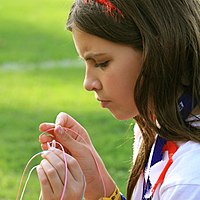
Photo from wikipedia
The use of colours is a prevalent and effective tool for improving design. Understanding the effect of colours on attention is crucial for designers that wish to understand how their… Click to show full abstract
The use of colours is a prevalent and effective tool for improving design. Understanding the effect of colours on attention is crucial for designers that wish to understand how their interfaces will be used. Previous research has consistently shown that attention is biased towards colour. However, despite previous evidence indicating that colours should be treated individually, it has thus far not been investigated whether this difference is reflected in individual effects on attention. To address this, a visual search experiment was conducted that tested the attentional guidance of six individual colours (red,blue, green, yellow, orange, purple) in increasingly complex displays. Results showed that the individual colours differed significantly in their level of guidance of attention, and that these differences increased as the visual complexity of the display increased. Implications for visual design and future research on applying colour in visual attention research and design are discussed.
Journal Title: Applied ergonomics
Year Published: 2019
Link to full text (if available)
Share on Social Media: Sign Up to like & get
recommendations!